All the
land birds on Diego Garcia were introduced by man,
or flew in from other islands. There are no
'native' land birds on Diego Garcia. There
seems to be continuing straglers arriving every
once in a while - in 1987-88, I noticed several
"lost" birds on the island. On the way out
to the plantation one day, I saw a hawk the size
and coloration of an immature Redtail hawk, but
with a shorter head and tail. It was in the
company of a bunch of noddy terns and was flying
through the trees beside one of the barachois. On
another expedition to the other side of the island
I saw a swallow or a swift, but I haven’t got the
slightest idea what species it was.
HERONS
I’m going to stick my neck way
out here with the herons. Although two
are very common on DG (the Striated and Cattle
Egret), the Gray Heron is not common, if it is
resident there at all. The reason I’ve
included the Gray Heron in this section is
that I personally saw several of them on DG in
1987 and 1988. Maybe someone reading
this can
confirm
or deny that they are there now.
The easiest way to tell if a
flying bird is a heron is the way it holds
its neck and head, and the semi-circular
shape of the wings (like a pair of those
flat panel parachutes). Typically
herons flap their wings slowly (the smaller
they are, the faster their wings flap), with
the neck retracted in a vertical S shape,
and the head tucked back between the
shoulders. This is characteristic of
herons and bitterns (which don’t seem to
inhabit DG), and distinguishes them from
storks or cranes, which extend their necks
out in front of their bodies while
flying. By the way, if you see a stork
or crane flying around, let
me
know!
Cattle
Egret (Bubulcus ibis)
Known
to the Ilois as “Madam Paton”.
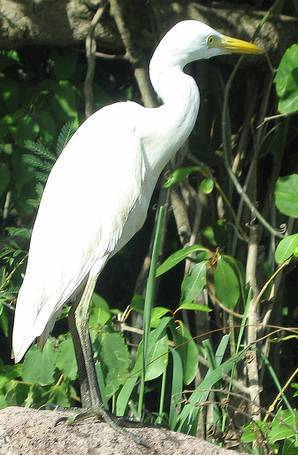 The Cattle Egret is probably
the most widespread and populous heron on
earth. They easily adapt to just about
any tropical or temperate environment.
If you live in the Southern or Western U.S.,
you’ve seen them following cattle and
tractors, and perhaps have even stumbled
across a rookerie near water. The Cattle Egret is probably
the most widespread and populous heron on
earth. They easily adapt to just about
any tropical or temperate environment.
If you live in the Southern or Western U.S.,
you’ve seen them following cattle and
tractors, and perhaps have even stumbled
across a rookerie near water.
On Diego Garcia, the ones
you see are probably hybrids of the African
subspecies, which were intentionally
introduced from the Seychelles in 1953,
combined with some of the Asiatic subspecies
had been blown down on the winter monsoon as
early as the 1880s.
This is a small, chunky
white heron, with a wingspan of about three
feet. As with most herons (and as
opposed to cranes) they fly with their necks
curved in an S-shape, and their heads tucked
in between their shoulders. It has a
relatively short, thick, orange-yellow,
pointed bill, yellow legs, and entirely
white plumage, except during the breeding
season. At that time, it develops some
buff colored feathers around the head and
shoulders, while the bill and legs turns
deep red.
Unlike other herons, Cattle
Egrets don’t hang around water. You
will probably see these egrets on the
airfield, or other large, cleared areas like
the soccer field or the lawns at the
Plantation, where they can hunt for the
insects which compose most of their
diet. You may even see them following
donkeys on the move across T-Site, catching
the insects stirred up by the donkey’s
passing.
During the breeding season,
they form rookeries in trees or large shrubs
on or very near fresh water, with a nest on
just about every limb. The nests are
made from sticks, and there are anywhere
from one to five eggs laid per nest.
This species is considered a
pest around airfields, where they show not
the slightest regard for aircraft noise, and
will fly directly in front of aircraft
taking off or landing, creating the
potential for tragic accidents. During
intense aircraft operations on Diego Garcia,
teams of airmen armed with shot-shells will
patrol the airfield and shoot these 12-gauge
equivalents of bottle-rockets in the
direction of egret flocks to scare them away
from the area. Apparently, the BIOT
has approved more direct action
and In 2006, an article about
control of egrets on Diego Garcia in the
USAF safety magazine "Combat Edge" reported
that the island population of Cattle Egrets
had been reduced to about 80 birds, which
could only be accounted for by killing.
Striated
Heron (Butorides striatus)
Known
to the Ilois as “Manique”.
Also
called the Little Green or Mangrove Heron.
This is the smallest heron
resident on Diego Garcia. The Striated
Heron is wide-spread indeed, from West
Africa east across tropical Asia, the IO,
and Pacific to the Americas. In the
Eastern Hemisphere, it’s found as north as
Japan, and south to Australia. It is
found on just about every tropical island in
its range, and is considered con-specific
(i.e., one and the same) as the Green Heron
of North America. If you’ve ever been
in a swamp in the good ‘ol USA, you’ve
probably seen these herons, and they look
and act the same on DG.
This little heron is usually
found where there are bushes over water –
salt or fresh, it doesn’t matter. This
bird has very short legs for a heron, and
doesn’t wade for its prey. Instead it
prefers to sit very still on a low branch,
its head pulled in tight to its shoulders,
staring into the water, waiting for a fish,
pollywog, or insect to come close. It
also will sit amongst rocks next to the
water’s edge, camouflaged by brush if
possible. Unless you are looking for
these quiet, stealthy birds, the first time
you know you are near one is when it finally
gets too nervous to continue to sit still,
and takes off like a shot, with a loud
croak, that, quite frankly, always scares
me.
Like other herons, it has a
very long neck, and the prey doesn’t have to
come too close for it to reach. One
neat trick Striated Herons are reported to
do the world over is use bait for their
hunting. They’ll take a feather or
dried leaf and drop it on the surface of the
water to attract prey. In the
Seychelles, they’ve been observed to use
bread crumbs that tourists throw to feed the
fish. Pretty smart.
These little herons are
resident on DG, and not migratory
birds. They build a platform nest of
sticks in shrubs or trees, usually near
water. They lay 2 – 5 eggs, and both
parents incubate, brood and feed the
chicks. The young don’t take long to
leave the nest. The eggs take just 20
days to hatch, and the young leave the nest
just three weeks later.
Although it is often called
a Green Heron, it appears to be mostly dark
grey when it’s sitting there on its low
branch. It has a greenish-black cap,
yellow skin around the eye, and a greenish
back that is hidden by the dark wings.
It has a lighter grey belly and yellow legs
and feet. Its bill is stout, almost
oversized, with a sharp point. Young
birds aren’t as glossy as their parents, and
are streaked with white, with greenish legs
and feet. See the photos below for
examples (the adult is on the left).
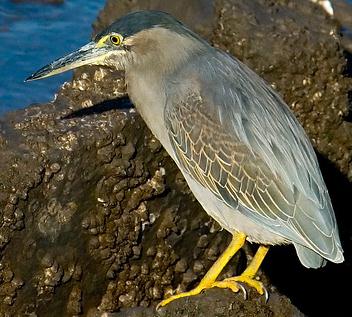 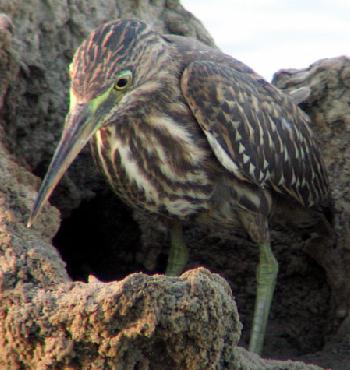
Gray
Heron (Ardea cinerea)
I’ve included this heron in
this list because I personally saw three on
DG in one day in 1988 - one was at the
borrow-pit south of the airfield, and two
were in Turtle Cove. The only other
record I found was from 1899, but this big
heron probably visits Diego regularly, if it
has not established residency.
The Grey Heron is the
largest heron in the Eastern Hemisphere,
standing over three feet tall, with a wing
span of six and a half feet, and is the
Eurasian equivalent of its close relative,
the Great Blue Heron of North America.
The Grey Heron is native to the temperate
regions of Asia and Europe, and also West
Africa and Madagascar. It migrates
from the northern part of its range, but
otherwise is a resident.
In color, it is grey above,
and buff below. The head is white with
a pinkish bill, and it has broad, black
eyebrows, and a black feather crest on top
of the head which drapes down the back of
the neck some distance. If you’ve seen
a Great Blue Heron fly, the Grey flies the
same way, slow, with wing beats that move
the body up and down. Like other
herons, it flies with its head tucked into
its shoulders.
There are four subspecies of
Gray Herons. The Gray Herons on DG are
most probably migratory vagrants from
Eurasia. In Europe, Africa and western
Asia the subspecies is A. c. cinerea, and
eastern Asia, it’s A. c. firasa. If
you find a dead one out there, be sure to
get it to the Brit Rep so he can have it
properly butchered, dissected, and
positively identified!
If Grays have taken up
residency on DG, you may be able to find a
small rookery in some tall trees close to
water. Gray Herons build a huge, bulky stick
nest – sometimes they are mistaken for eagle
nests. No other bird on DG will build
this kind of nest, so if you see one, keep
an eye out for the occupants, and stay away
as much as possible. Large herons are
easily driven off their nests and you
wouldn’t want the young to suffer.
Oh, if you heard a loud
croaking “AAAAAANNNKKKK”, it’s a Gray
Heron. The picture below shows a Gray
Heron in typical Heron-style flight - curved
wings, and head tucked into the shoulders.
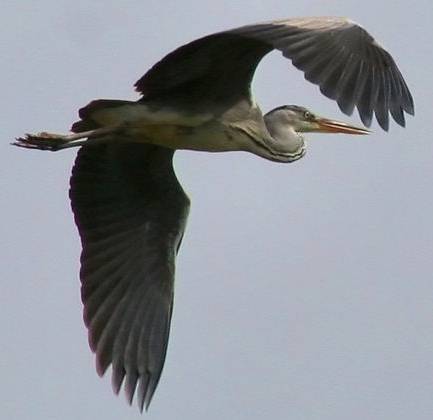

LAND
BIRDS
All
the land birds on Diego Garcia were introduced by
man, or flew in from other islands. There
are no 'native' land birds on Diego Garcia.
There seems to be continuing straglers arriving
every once in a while - in 1987-88, I noticed
several "lost" birds on the island. On the
way out to the plantation one day, I saw a hawk
the size and coloration of an immature Redtail
hawk, but with a shorter head and tail. It
was in the company of a bunch of noddy terns and
was flying through the trees beside one of the
barachois. On another expedition to the other side
of the island I saw a swallow or a swift, but I
haven’t got the slightest idea what species it
was. And as mentioned above, I saw Gray
Herons regularly in those days.
Well,
here's some land birds that managed to overcome
all the odds and colonize the island, despite
the best efforts of mother nature, and the
British bird butchers (at least when it comes to
our first selection):
Domestic
Fowl (Gallus gallus)
Most
commonly called chickens!
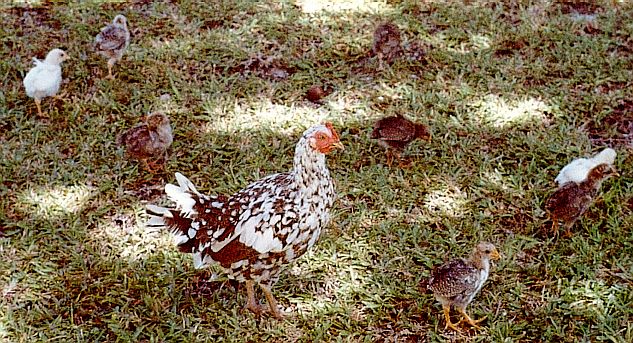
There are 8
chicks in this photo!
Chickens
were everywhere on the inhabited side of the
island, but there were none over by the plantation
until the Space Commandos snuck some over to the
plantation and GEODSS Site in 1987, after which
they were all over over there too! Also the
chickens could really scare you at night, as they
roosted in bushes and if frightened themselves
would flop around and make a lot of noise you
weren't expecting.
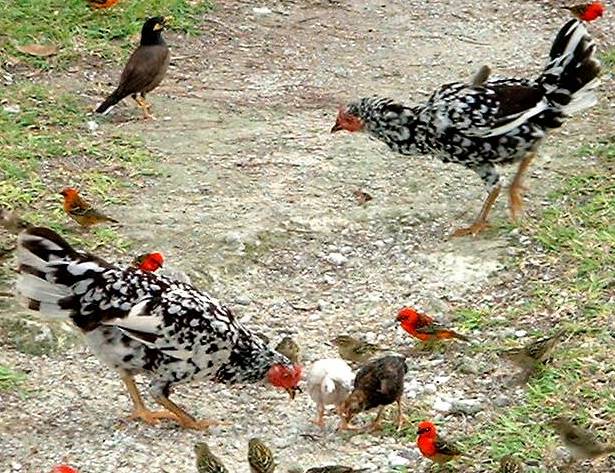
Here
are Chickens (two hens and two chicks), a
Common Mynah, and Madagascar Fodies (the males
are in the red breeding plumage, the females
look like sparrows). All the land birds
of Diego Garcia hang together, when it comes
to raiding picnics. Photo by Bob Ralph,
2002.
Here
are some birds that were reported as positively
released by man (according to Hutson in Atoll
Research
Bulletin No. 175):
Cattle Egret (Ardeola ibis):
Nine (9) of these birds were imported from the
Seychelles and released in 1953. In 1971
the only nesting colony found (estimated to be
10 nests) was located in a large mango tree near
the Plantation. In 1982 there were
anywhere from a few dozen to a couple hundred;
by 1987 they could be seen in flocks of 4 or 5
on the airfield, and by 2001 were a serious
Bird/Aircraft Strike Hazard at the airfield, and
the USAF would attempt to scare them away with
shell crackers, harassment in their nearby
rookeries, and shooting when all else failed.
Indian
Barred Ground Dove (Geopelia striata):
Reportedly 16 birds were brought to DG in
1962, and 12 were released. It can now
be found all over the island.
Indian
Mynah (Acridotheres tristis): Twelve
were brought from Agalega island in the
Seychelles and released in 1954 or 1955.
In the early 1970s the SEABEES used to catch
these birds, keep them in makeshift cages, and
attempted to teach them to talk (with varying
reports of success).
Indian
Barred Ground Dove (Geopelia striata)
Known to
the Ilois as “Turtur cocos”.
Also called
the Zebra Dove.
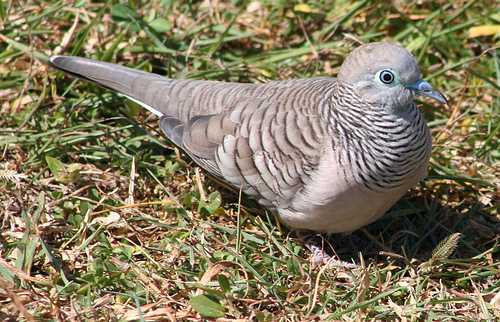
Turtle
Dove (Streptopelia picturata)
Known to
the Ilois as “Turtur des iles”.
Also knows
as the Madagascar Turtle Dove, Painted Dove,
or Red Turtle Dove.
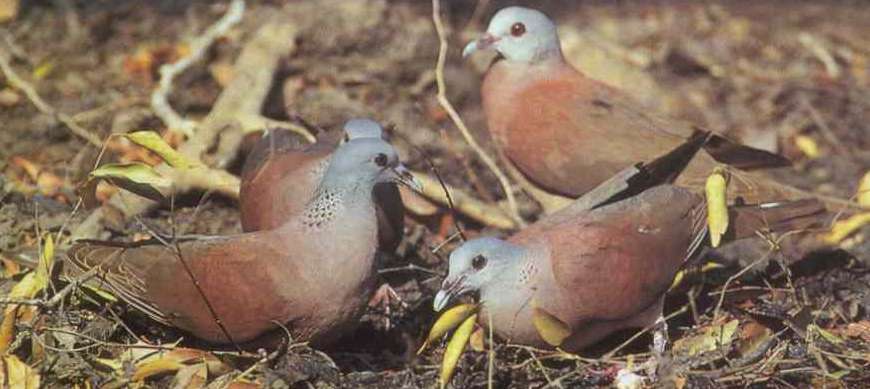
Indian
Mynah (Acridotheres tristis)
Also known
as the Common Mynah.
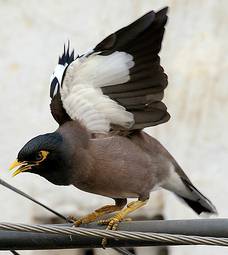
Madagascar
Fody (Foudia madagascariensis)
Also known
as the Red Fody.
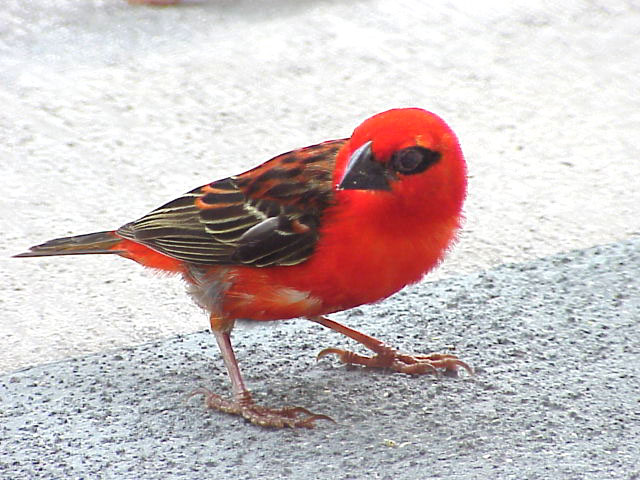
Male
Madagascar Fody in breeding plumage.
|
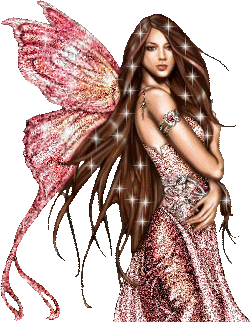
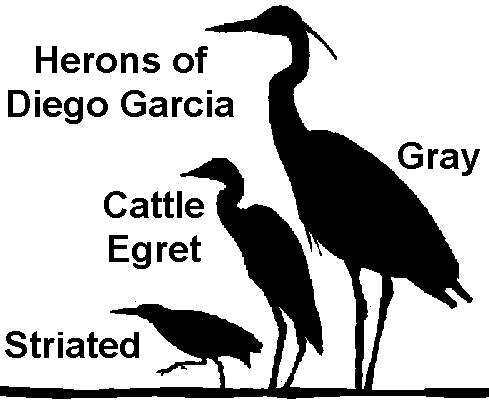



 The Cattle Egret is probably
the most widespread and populous heron on
earth. They easily adapt to just about
any tropical or temperate environment.
If you live in the Southern or Western U.S.,
you’ve seen them following cattle and
tractors, and perhaps have even stumbled
across a rookerie near water.
The Cattle Egret is probably
the most widespread and populous heron on
earth. They easily adapt to just about
any tropical or temperate environment.
If you live in the Southern or Western U.S.,
you’ve seen them following cattle and
tractors, and perhaps have even stumbled
across a rookerie near water.




